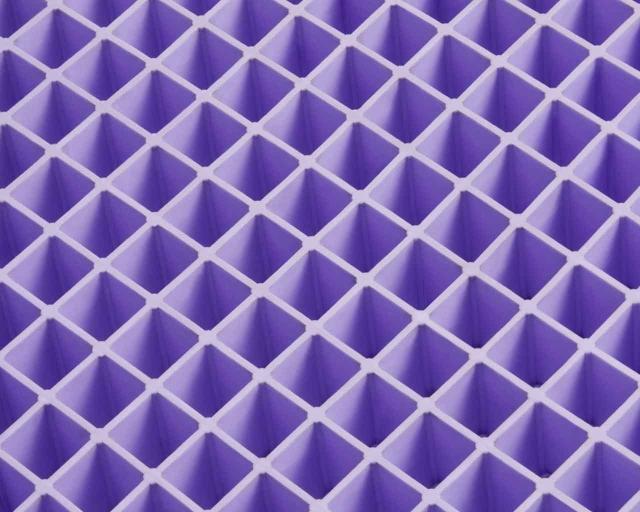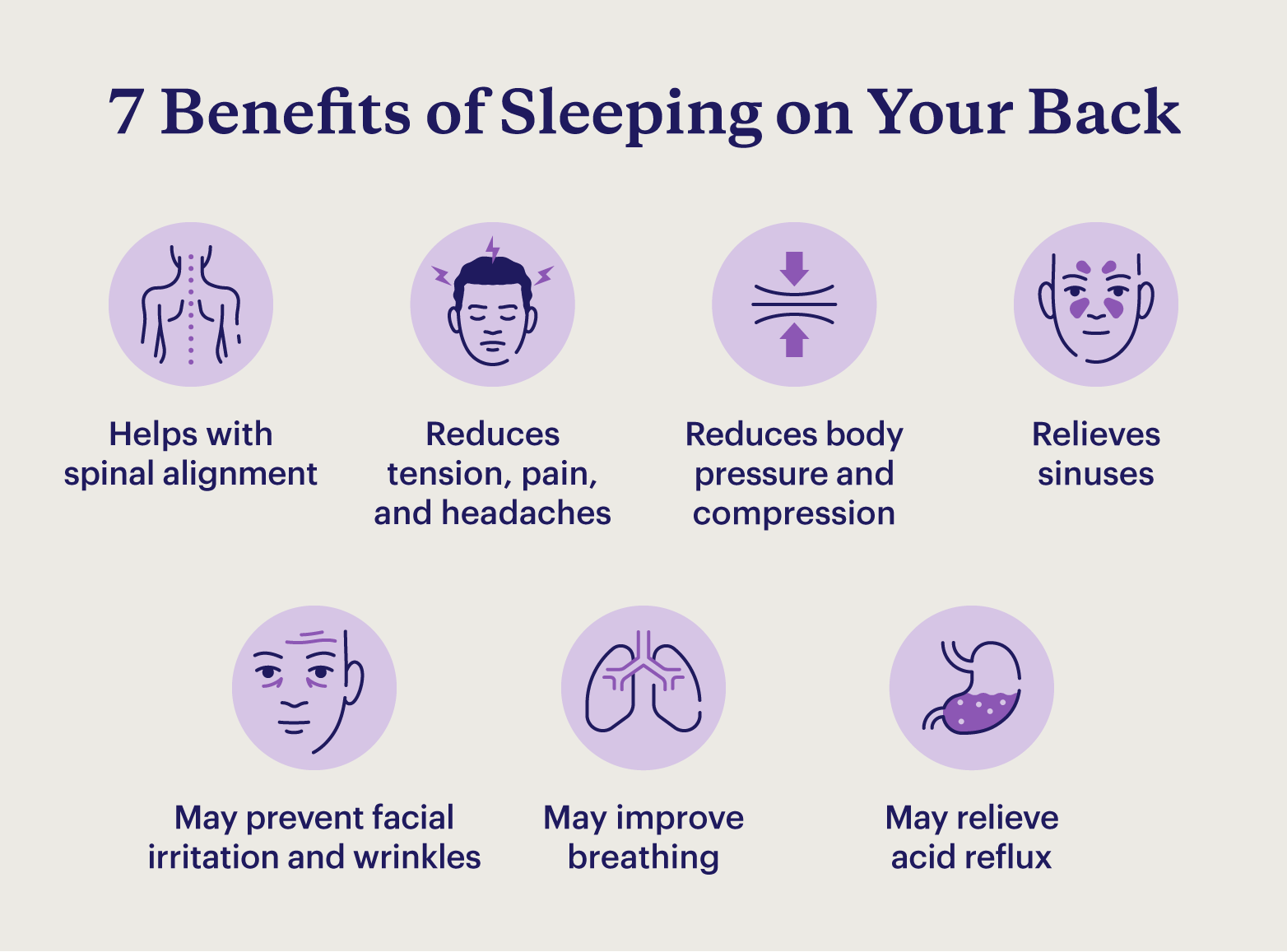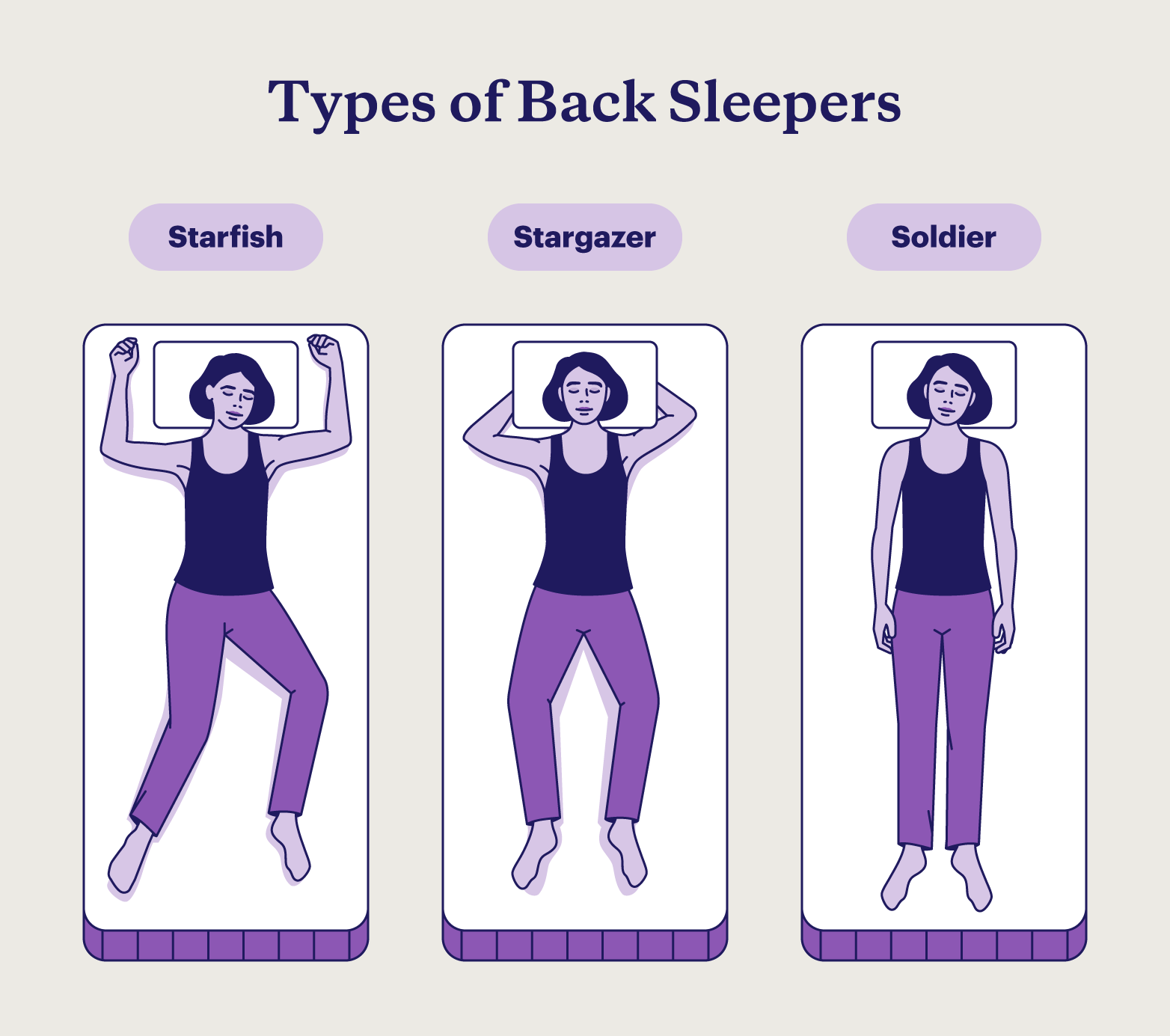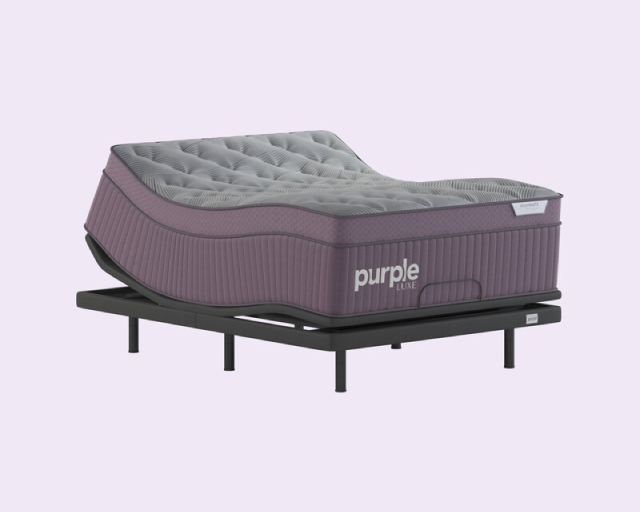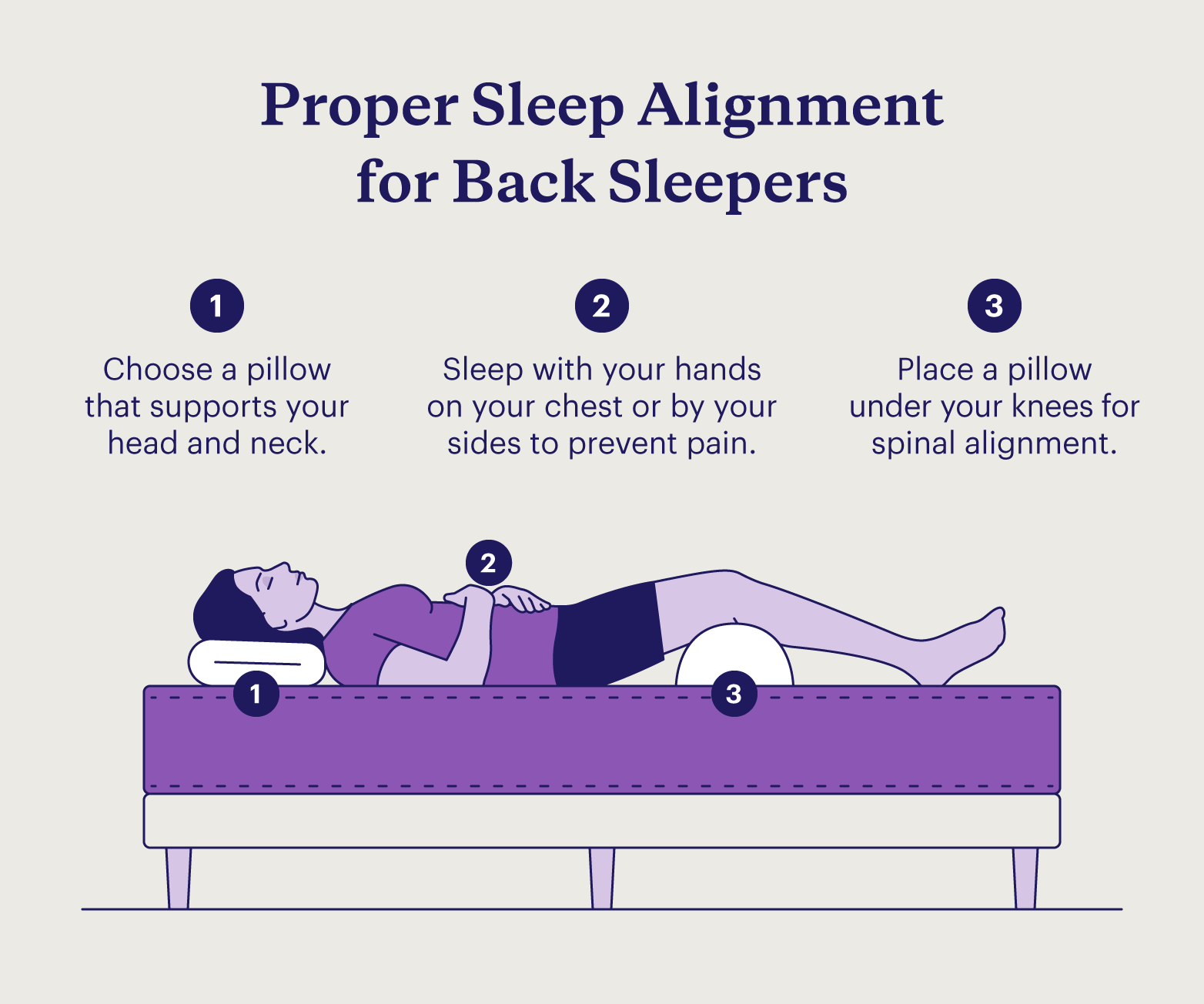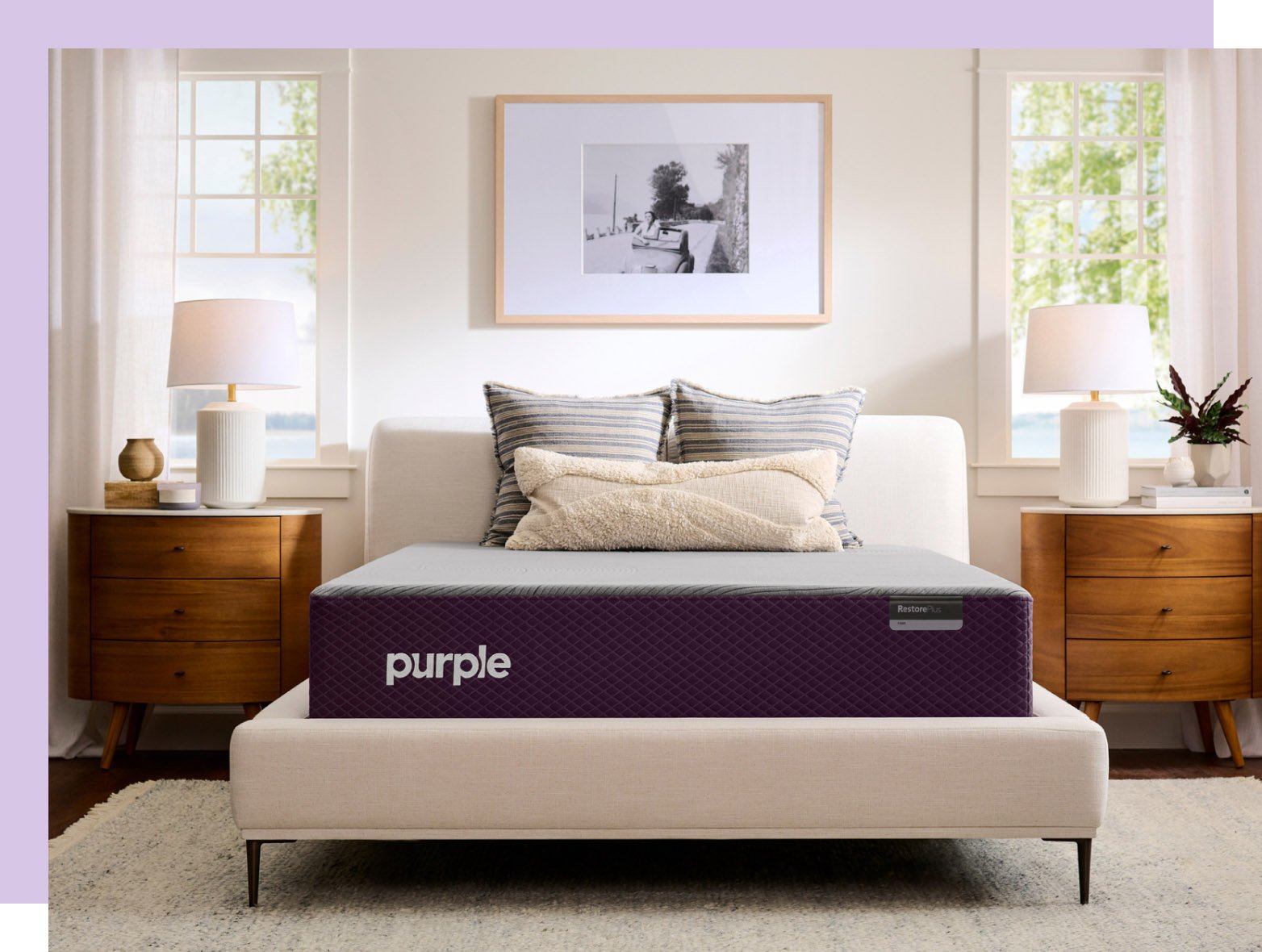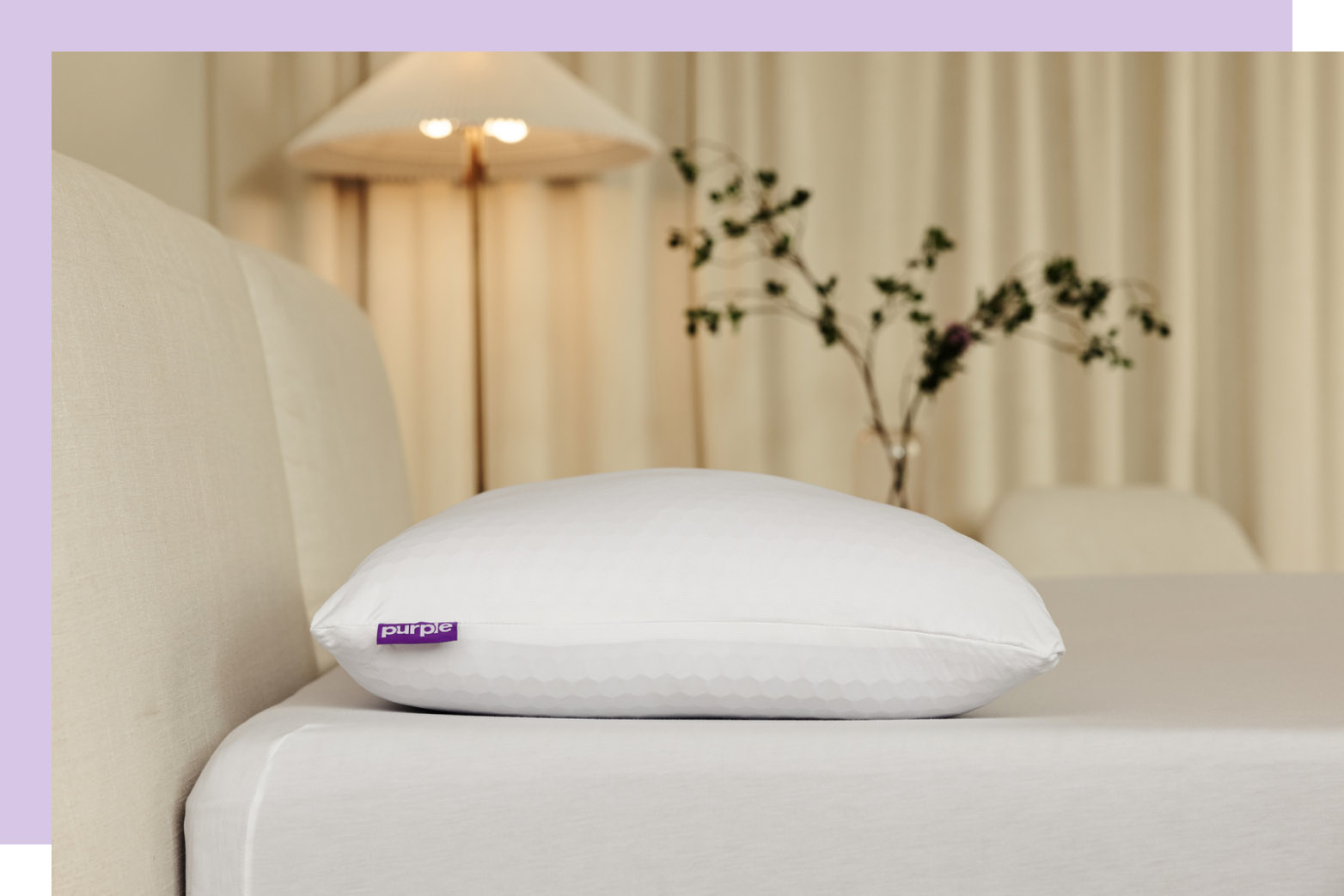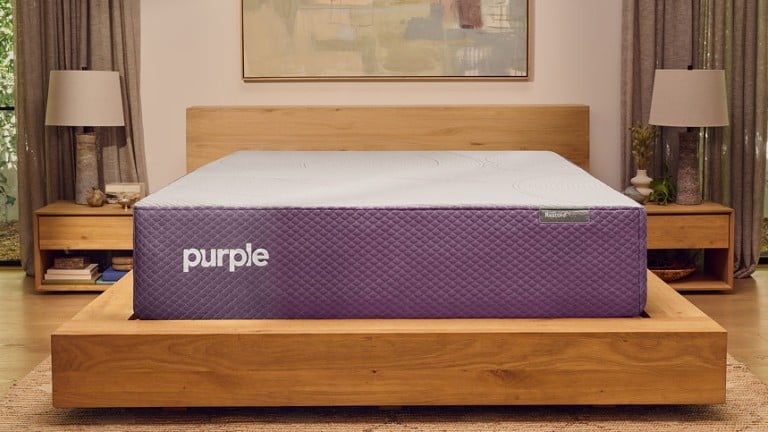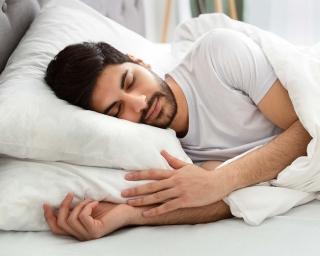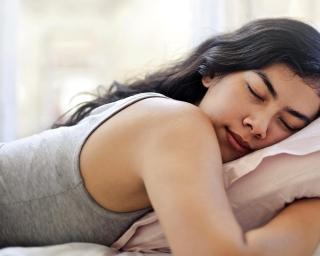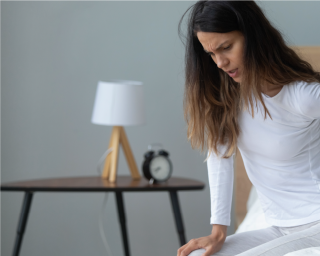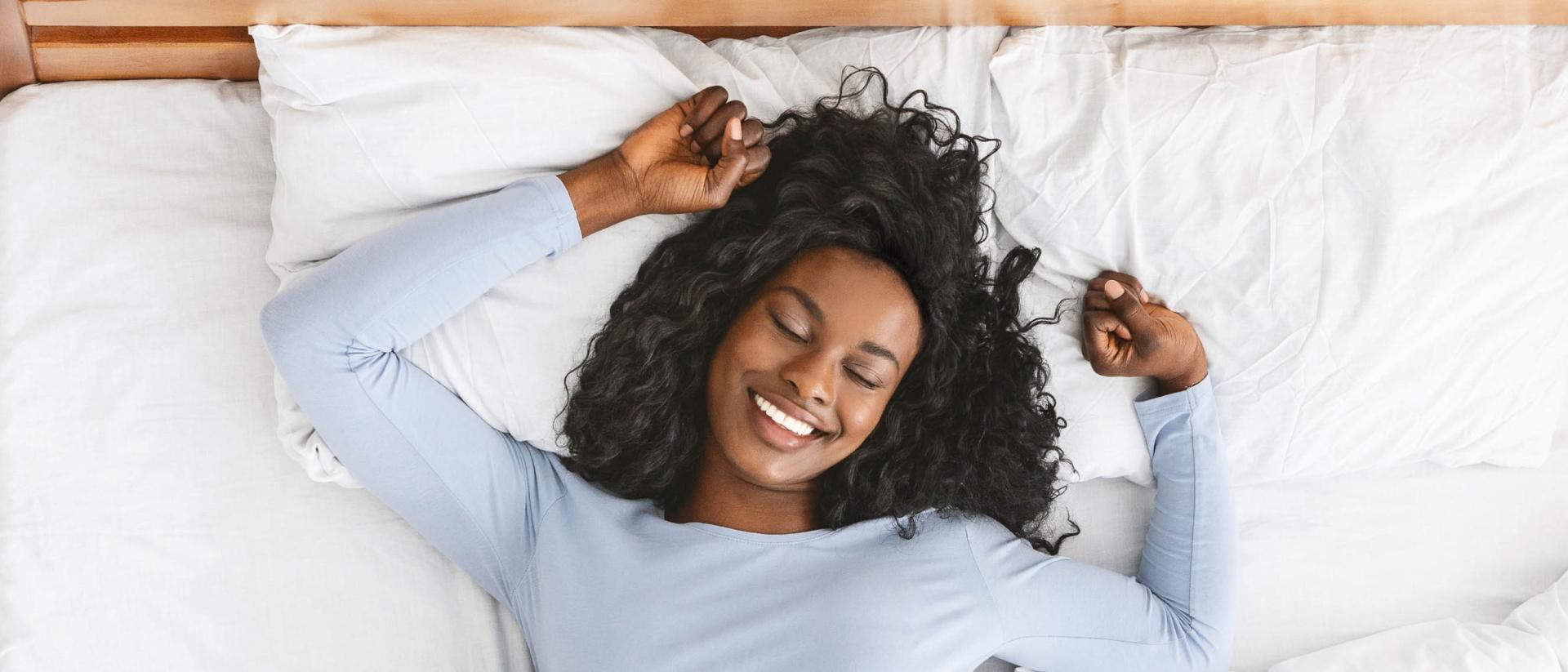
The Complete Back Sleeper Guide: Benefits, Tips, and Accessories
Key Takeaways:
- Back sleepers may have less back pain and stiffness than other sleepers.
- Sleeping on your back can promote your spine’s natural alignment, reduce pressure and pain, and improve your breathing.
- You can train yourself to sleep on your back by using pillows; place them under your knees and around your body to keep yourself in place and relieve pressure from your hips.
Sleep position is a key factor that impacts the quality of your sleep. Around 37% of people spend most of the night sleeping on their backs, which is one of the healthiest sleep positions.1 The benefits of sleeping on your back can be extensive, from reduced pain to sinus relief.
While it can be a healthy position, the supine sleeping position isn’t ideal for everyone. It’s important to learn about different sleep positions to determine what works best for you. Keep reading to learn how you can improve the quality of your rest by sleeping on your back.
Benefits of Sleeping on Your Back
When combined with healthy sleep habits like choosing a supportive and comfortable pillow, sleeping on your back may improve your sleep quality. Every sleep style can be beneficial for different people, so it’s important to listen to your body and account for your preferences.
Here are some of the many benefits of sleeping on your back:
1. Helps With Spinal Alignment
The best sleeping position is often considered to be whatever position best supports your spine. The supine position is the closest to a relaxed standing position, meaning it promotes healthy spinal alignment, especially when supplemented with supportive pillows.
You’ll want to find the ideal pillow height that lifts your head and accommodates the natural curve of your neck to prevent pain and discomfort while sleeping on your back. Additionally, sliding a pillow under your knees can alleviate pressure from your hips while promoting proper alignment.
2. Reduces Tension, Neck Pain, Headaches, and Shoulder Aches
Many of us have experienced waking up tired, achy, and grumpy. While unrestful sleep can be attributed to several factors, your sleep position can have a large impact on your pain and discomfort in the morning.
Tension headaches and shoulder pain are common in side sleepers, but sleeping on your back tends to reduce these symptoms.2 In one 2017 study, researchers found that sleeping on your back with your hands on your chest or at your sides may reduce the amount of neck pain you experience overnight.3
If you’re experiencing pain, soreness, stiffness, or discomfort during the night and when you wake up, try sleeping on your back to alleviate these symptoms. You can also consider some of the best mattresses for shoulder pain to provide more pressure relief. And if you prefer to sleep on your side, choosing the best pillow for side sleepers can help reduce tension by properly supporting your neck and shoulders. In cases of severe or chronic pain, you may want to invest in a mattress for back pain relief or a pillow for neck support.
3. Reduces Body Pressure and Compression
As we get older, back pain and spine compression become more common, but you can reduce the severity of these issues by adjusting the way you sleep. Beyond sleeping on a firmer mattress, sleep experts say that minding your alignment during sleep makes a huge difference.
A 2019 study on pain and sleep position determined that, of the three most common sleeping positions (supine/back, side, and prone/stomach), sleeping on your side or back results in less pain and pressure than sleeping on your stomach.4 Back sleepers put less pressure on their lower backs and hips, especially with a pillow under their knees, because their weight is more evenly distributed while sleeping, resulting in less compression.
When you choose a mattress that adapts to your body as you move and cushions your pressure points, lying in a supine position becomes even more comfortable, even if you change positions overnight.
4. Relieves Sinuses
Trying to sleep while congested may mean struggling to fall asleep, waking up often, and keeping your partner awake with your snoring. In most cases, lying on your back can make sinus pain worse, but there’s an easy way to sleep on your back and relieve your sinuses.
If you’re feeling congested or have sinus pressure, opt for a fluffy pillow that keeps your head elevated while you sleep on your back. Doing so can relieve these issues and encourage natural draining, which means you’ll have clearer airways overnight. You can also use an adjustable bed frame to get similar results.
5. May Prevent Facial Irritation and Wrinkles
If you sleep with your face pressed into your pillow, you’re more likely to experience facial irritation and breakouts — in fact, sleeping on your stomach or side has been linked to an increase in acne, neck wrinkles, and fine lines.5 When you sleep on your back, you reduce the risk of dirt and oil buildup and irritation that can result from contact with your pillowcase.
Compared to people who sleep on their backs, stomach sleepers have a higher likelihood of developing premature wrinkles. By sleeping on your back, you may notice that your face is cleaner and smoother than if you sleep in any other position!
6. May Improve Breathing
Sleeping on your stomach is often considered the riskiest sleep position because it can cause issues with alignment, numbness, pain, and even breathing. Even with a good mattress for stomach sleepers, you can risk spinal misalignment and daily aches. Lying on your stomach can compress your diaphragm, making it hard to take full breaths and impacting your overall sleep quality. You can avoid these potential issues by sleeping on your back, which may improve your breathing overnight.
Regardless of your preferred sleep position, if you find yourself waking up in the middle of the night feeling out of breath, you may be suffering from obstructive sleep apnea and should contact your doctor as soon as possible.6
7. May Relieve Acid Reflux Symptoms
Acid reflux can be a major contributor to disrupted sleep, making it difficult to fall asleep, stay asleep, and get high-quality rest.7 Sleeping on your back may be one of the best positions to relieve acid reflux symptoms because it puts you in the best position to elevate your head, preventing stomach acid and food from rising in your esophagus.8
Pros of Back Sleeping | Cons of Back Sleeping |
| Keeps your spine naturally aligned | May make lower back pain worse |
| May reduce neck pain, shoulder tension, and headaches | Can increase sleep apnea symptoms |
| Can prevent wrinkles and breakouts | Often not recommended for pregnant individuals |
| May relieve sinus congestion and acid reflux symptoms | Can make snoring worse |
Drawbacks of Sleeping on Your Back
While the supine position can be beneficial in many ways, it isn’t always suitable for everyone. You may not want to sleep on your back if any of the following apply to you:
- You are pregnant: When you’re pregnant, sleeping on your back can decrease blood flow to your baby. Doctors tend to advise pregnant individuals to sleep on their sides with a pregnancy pillow instead.
- You suffer from sleep apnea: Lying on your back may make sleep apnea symptoms worse, because the position can cause your chin to drop, making breathing more difficult. You want to choose a good mattress for sleep apnea and avoid positions that can worsen symptoms.
- You have chronic lower back pain: This isn’t the case for everyone, but some people with lower back pain report that sleeping on their backs can make the pain worse. You may also experience back pain from sleeping on a new mattress regardless of your sleep position. You can alleviate some back pain with a pillow under your knees, but you should ultimately choose a position that keeps you comfortable.
- You snore a lot: Sleeping on your back often makes snoring worse because you’re more likely to have your mouth open with your tongue falling back in your mouth. So if you don’t want to disrupt your or your partner’s sleep, back sleeping may not be the best option. You might try following some tips to stop snoring if this position is comfortable for you.
- You don’t like the position: Sometimes, lying on your back just isn’t for you. Maybe it isn’t comfortable, or maybe it’s hard for you to stay on your back. Ultimately, you should find a sleep position that works best for you.
In most cases, this sleep position has far more benefits than downsides, so if you don’t relate to any of the above points, you may want to consider sleeping on your back to get better rest.
Back Sleeping Positions
There are a few variations of the supine sleeping position you might consider to improve your comfort and sleep quality. If you want to try a new back sleeper position, start with these three common options:
Starfish
Sleepers who prefer the starfish position have their legs spread and their arms raised so that their hands rest near their heads. This position can help prevent shoulder and neck pain.
Stargazer
The stargazer position is similar to the starfish, but these sleepers put their hands under their heads, almost as if they were gazing up at the stars. While sleeping in the stargazer position, sleepers may keep their legs slightly bent or close together.
Soldier
In the soldier position, sleepers keep their arms and legs straight, like a soldier at the ready. This position is arguably the most common among back sleepers, but it can contribute to back pain and acid reflux if you don’t properly support your head and neck.
How To Train Yourself To Sleep on Your Back
If sleeping on your side or stomach isn’t comfortable, you can learn to sleep on your back! Learning how to become a back sleeper may be productive, especially if you wake up with aches and pains, have trouble sleeping, or can’t get comfortable in bed.
Here are some tips for sleeping on your back to help you make the transition:
Tip #1: Invest in an Adjustable Bed
You can alleviate several of the common disadvantages of sleeping on your back by investing in an adjustable bed. With an adjustable bed frame, you can keep your head elevated to relieve sleep apnea and acid reflux symptoms. These frames can also support your back and knees to keep you comfortable and pain-free.
Tip #2: Place a Pillow Behind Your Knees and Lower Back
Sleeping on your back can be beneficial, but without proper support, you can put excessive pressure on your neck and lower back. Placing a pillow under your knees can help you stay aligned and comfortable all night long. Under the knees is a good pillow placement for back pain relief in general. Knowing how to sleep on a pillow as a back sleeper can prevent discomfort and help you sleep more soundly.
The Purple Harmony™ Anywhere Pillow is a great option for back sleepers to place behind their knees. With its compact size and airy feel, this pillow provides just the right amount of support for your knees and back.
Tip #3: Surround Yourself With Pillows
If you’re having trouble staying on your back overnight, you can create a pillow wall around yourself to keep you from rotating. You won’t have to do this forever, but some extra guidance while you’re trying to learn how to sleep on your back may be helpful.
Tip #4: Avoid Eating Before Bed
If you don’t elevate your head enough, there’s a chance that sleeping on your back can worsen acid reflux symptoms. You can reduce the risk of acid reflux in general by limiting what you eat before going to sleep. Generally, you want to avoid eating right before bed, but you should especially avoid spicy, fatty, or acidic foods as well as alcohol and caffeine, as these can cause acid reflux overnight.
If you need to eat before bed, small snacks or simple meals are best.9 You can also eat foods to improve your sleep quality. Elevating your head with a pillow can also help mitigate acid reflux.
Tip #5: Be Patient
Trying to change any habit takes time. If you’re struggling to make the shift to sleeping on your back, you’re not alone.
Stay relaxed and be patient over the first few nights. Chances are, you’ll still be tossing and turning for a little while, but that’s completely normal. Try not to get discouraged, and remember that the long-term benefits of back sleeping are often worth the adjustment period.
Best Mattresses for Back Sleepers
When searching for a back sleeper mattress, your individual preferences are what matter most. However, some common features may be appealing to back sleepers, including firmness, contouring, comfort, and durability.
If you sleep on your back, you need a comfortable mattress with materials and features that support your back. For maximum comfort and alignment, compare Purple mattresses that adapt to your body and provide support and pressure relief so you can sleep soundly no matter what position you prefer.
For back sleepers, we recommend the following options:
- Purple RestorePlus™ Hybrid Mattress: The combination of our proprietary GelFlex Grid® (or Gel Matrix™), Ultra Comfort Foam, and Edge-to-Edge Coils makes this Purple Hybrid™ an adaptive, supportive mattress that cradles your body and provides extra support in the hip and lumbar region, making it a perfect choice for most back sleepers.
- The Purple Mattress®: With our adaptive GelFlex Grid® and layers of Comfort Foam, our original Purple Mattress® provides plenty of support and pressure relief for back sleepers.
- Purple Rejuvenate™ Mattress: Featuring our revolutionary DreamLayer™ technology, this luxury mattress offers decadently plush surface comfort and enhanced temperature bliss with 2” GelFlex Grid®, responsive coils, and active response foam.
Our revolutionary Matrix™ technology adapts to your body, cradling pressure points and supporting spinal alignment for maximum comfort. Of course, there is no one-size-fits-all mattress for back sleepers. Your preferences for firmness, cushioning, and cooling should take priority when choosing a mattress.
Best Pillows for Back Sleepers
Keeping your neck supported and aligned is important for back sleepers. Using a pillow that is too thin or too thick can cause pain and stiffness that worsens your sleep quality.
The best pillow for back sleepers will be one that supports the natural curvature of your neck and keeps your airways open by elevating your head and shoulders. If you’re looking for a comfortable back sleeper pillow, compare Purple pillows to find one that supports and comforts your neck. We generally recommend the following options for back sleepers, though it ultimately comes down to personal preference:
- Purple Freeform™ Pillow: Our Purple Freeform™ Pillow provides targeted neck support that you can adjust to your preferences. With removable fill and our GelFlex Grid®, you can customize it to a height that keeps your shoulders elevated with added neck support to enhance spinal alignment and prevent discomfort.
- Purple DreamLayer™ Pillow: You can adjust our medium-soft Purple DreamLayer™ Pillow to best support your head and neck at any height with removable Booster layers. The DreamLayer™ will mold to your shape and provide the support you need to sleep well.
- Purple Harmony™ Pillow: Available in three heights, the Purple Harmony™ Pillow features our GelFlex Grid® for pressure relief and cooling. This medium-firm talalay latex pillow cradles your head and neck to offer contoured support for spinal alignment.
When To Consider Other Sleep Positions
Depending on your health and preferences, becoming a back sleeper may not be the best choice for you. Sleeping on your back isn’t always recommended for people who:
- Are pregnant
- Have sleep apnea
- Have heart disease
- Have lung disease
- Suffer from lower back pain
- Snore a lot
While sleeping on your back can be beneficial, this position is not suitable for everyone. It’s important to choose a sleep position that feels comfortable and doesn’t worsen any existing conditions.
FAQ
A supine position simply means sleeping on your back. This position is more common than sleeping prone, or on your stomach, and has a number of benefits, including back pain relief and spinal alignment.
Doctors often advise against sleeping on your back when pregnant because this position can increase the risk of complications or restrict blood flow to your baby.10 The best sleep position during pregnancy is usually on your side. However, you should ask your doctor for their recommendation before making any changes to your sleep habits while pregnant.
It may take anywhere from a few weeks to a few months to train yourself to be a back sleeper. The transition period will vary from person to person, but just like any other habit, making a consistent effort to switch your sleep position is key.
Back sleepers spend most of their time sleeping lying on their backs, often with their arms by their sides or resting on their pillows. These sleepers may have the least amount of back pain and stiffness because their backs are supported and aligned throughout the night.
Back sleepers are the second-most common type of sleeper, between side sleepers (the most common) and stomach sleepers (the least common). One 2017 study found that sleepers spent more than one-third of their sleep on their backs, but more than half the time sleeping on their sides.1
More To Explore
Level up your sleep routine with our most-loved products.


